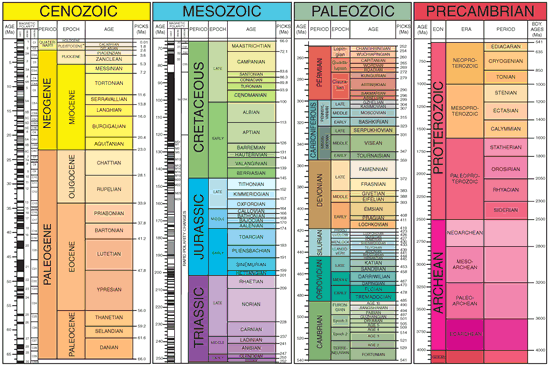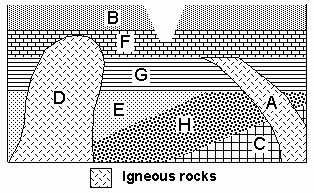The Paleozoic Era was the era of evolution which lasted from 544 million years ago to 245 million years ago. Following the Pre-Cambrian Eon, the Paleozoic period started the biggest biological change for all organisms on earth and for many millions of years to follow. The Paleozoic Era saw the formation of the supercontinent Gondwana. The supercontinent had South America and Africa with Antarctica, Australia, India at the bottom right of the South America-Africa combination. This supercontinent was located at the southern hemisphere of earth. In addition to Gondwana, there was also the supercontinent Laurasia which was North America with Eurasia at the northern hemisphere. By the end of the era, Gondwana and Laurasia began to separate and form the continents in the Mesozoic era.
As I have stated previously, the Paleozoic Era had the biggest biological change. The Carboniferous period produced a lot of carbon which in turn, made many plants. Progymnosperms look very similar to gymnosperms and conifers, except that the progymnosperms create spores to reproduce. There were also glossopteris which lived from 300 MYA to 200 MYA. These were plants that contained wood and had tongue shaped leaves. Cycads are plants with a crown of large leaves with a thick trunk and fairly resemble small palm trees. They are very scarce and are not as common than they were in the Paleozoic-Mesozoic era.
Along with plants, there were animals. However, they were aquatic because the Paleozoic Era was a major biological change mostly for aquatic organisms and was only the beginning for evolution for them. The most common one was the trilobite which was the most earliest anthropod you could find in earth's history and looked like a very fat centipede. It first appeared during the early Paleozoic and went extinct during the mid Paleozoic era. There was also the blastoid echinoderms which resembled starfish and like the starfish, lived underwater. They went extinct during the late Paleozoic era (Permian Period) due to the Triassic extinction which saw the largest mass extinction in the world. Branchiopods were the earliest versions of plankton and as such were like plankton. However, along with the blastoid echinoderms, they went extinct during the Triassic extinction.
During the Paleozoic Era, the climate was rather warm. Throughout the early to late Paleozoic Era, it was warm due to the fact that many glaciers had melted from the late Pre-Cambrian era. However, there was a small bump in climate during the Devonian period which may have occurred due to the fast evaporation rates, but went back down as the Carboniferous period took over. The last period, the Permian, saw a massive spike in temperature. This happened because of the formation of Pangea. When landmasses stuck together, it created mountains, but gave opportunity for volcanoes to form as well, which may have led to the Triassic extinction. The noticeable geological changes were first seen during the Ordovician period during the formation of Gondwana and Laurasia which created the Paleo-Tethys, Pathalassic and Iapetus Ocean. During the late Ordovician period, rapid sea-floor spreading occurred which created the Rheic Ocean between Laurasia and Gondwana. The Permian period saw the beginning of the formation of Pangea which meant that landmasses came together to form mountains and volcanoes.
The Paleozoic Era was the era that began life. It was warm which made it suitable for basic life. The formation of Gondwana and Laurasia helped that happen. During the Paleozoic Era, plants such as progymnosperms, glossopteris and cycads along with the many marine animals such as trilobytes, blastoid echinoderms and branchipods had the chance to evolve and some even became some of the animals we know today. The era saw the beginning of Pangea, which meant that landmasses came together. This formed mountains and began forming volcanoes. Although the era ended with mass extinction, it made way for the Mesozoic Era, where the spotlight shined on the dinosaurs.
Monday, September 18, 2017
Sunday, September 17, 2017
The Geological Time Scale - (9/11 - 9/17)
 |
| Image Source: https://goo.gl/G6icTZ |
Summary:
The Geological Time Scale is a calendar for all the major events that happened on earth. The time scale has eons, which are the biggest unit of time. Eons are incredibly long- so far there are only two in the Earth's life of 4.5 billion years. The first eon is the Pre-Cambrian eon, which was the eon before life on earth and was the setup for the Phanerozoic Eon, which is the eon in which life begun. We are still currently in the Phanerozoic Eon. Eons on the geological time scale are then split into eras. The Pre-Cambrian Eon is split into the Hadean, Archean and Proterozoic Era. The Phanerozoic Eon is split into the Paleozoic, Mesozoic and Cenozoic eras. The Paleozoic era was the beginning of life on earth, especially for aquatic life. The Mesozoic era was the era of the dinosaurs, and the Cenozoic era saw the rise in mammals being the dominant species.
SP6 - Constructing Explanations:
This week I constructed explanations through the work of my research of the Geological Time Scale. Currently, I am studying the Paleozoic Era. So far, I have found out that the Paleozoic Era was the beginning of life on earth and was a step forward in evolution, especially for aquatic life and plants. Arthropods who are the ancestors of spiders and Trilobites are some prime examples. The super-continent of Gondwana also formed during that era. As I found more and more information about the Paleozoic Era, I constructed explanations about the major events in that era through my notes and shared a bit of information with my team.
Thursday, September 7, 2017
History of Rocks (9/5 - 9/10)
 |
| https://goo.gl/VHHwCo |
Summary:
Rocks are everywhere on earth. They may seem inexpensive and invaluable since there is a lot of them, but some rocks can tell a lot about the earth. Fossils are rocks that preserve the remains of deceased organisms. There are resin fossils which preserve insects through the sap of a tree, trace fossils which document activity from deceased organisms from bite marks, footprints, etc, and body fossils that preserve the bones of dinosaurs when they were near a body of water. It is impossible to find the absolute age of the rocks, or the number of years since it formed, since the rock doesn't specify such information. Instead, you have to find its relative age based on the location and circumstances of where you found the fossil. The deeper the rock is, the older it is, unless it is a fault or a cut through the layers of rock.
SP2 - Using models:
This week I used models to help illustrate what the rock cycle looks like. The first step was to get four starbursts, and cut them into strips, then into bits. Scramble the bits and then evenly divide them into four. Next, grab one fourth of the starburst bits and crush them into your hands, molding them together to simulate how sedimentary rocks form. Then, apply heat and pressure onto the molded bits by putting the fused bits into a Ziploc bag and pressing down on it with a text book. This will simulate the formation of metamorphic rocks. The final step is to microwave the metamorphic rock for two minutes and observe the changes. This will simulate the formation of magma when the metamorphic rock melts and then the formation of igneous rocks when the melted starbursts cool down and harden. This activity helped me when finding out the age of rocks since it helped me visualize how igneous rocks are usually younger than the rocks beneath it.
Subscribe to:
Comments (Atom)